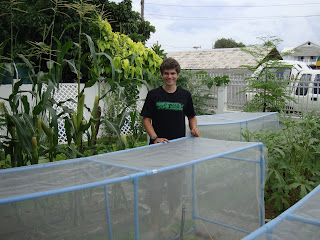ECHO Asia Intern
Back when Janis -- our now departed intern of yore -- was setting up an irrigation for our moringa plots (http://sustainabilityquest.blogspot.com/2011/06/add-water.html), it was decided that better pressure for the existing irrigation network in our main production plots was also needed. Once the rainy season is over, we will need to get water out of our pond, up a hill, and back down into the plots; however, our motorized pump keeps breaking. What to do? Appropriate technology to the rescue!
As an aside, there is an ongoing debate about the actual appropriateness of what has been labeled “appropriate technology.” Protagonists define “appropriate technology” as “using what you have to make what you need,” (Doerr).* Antagonists complain that the term is just a euphemism to soothe the consciences of those who don’t want to provide modern technological advances to the poor. The debate can go deep, and, initially, you may be tempted to side with the antagonists, but from our end, with our modern, electrically-run pump constantly on the fritz, we are championing the protagonists. Read a little further and see if you find yourself changing camps.

The building of the “rope and washer pump” took just two men and three days. Using PVC plastic piping, rubber washers, nylon rope, an old bicycle, and a little cement to hold it in place, they created a hand-crank system that can pump 20 liters per minute from the pond up the hill and into our water storage tanks! These items were either already available on the farm or found in our local market. A person standing by the pump simply turns the crank, feeding the rope with washers spaced at regular intervals over the bicycle wheels down into the water and back up through the PVC. Forced along the rope by the washers, the water makes the trip from the pond to the tanks with only a little escaping at the apex of the system. In a matter of minutes a 100 gallon tank is filled! Dry season, here we come!
*Doerr, Elizabeth. "Introduction to Appropriate Technology." Internship Lecture Series. ECHO. Appropriate Technologies Demonstration Center, ECHO Farm, N. Fort Myers, FL. 2009. Lecture.
** The Karen Baptist Convention or KBC was established in Myanmar in 1913. It currently includes 20 associations which seek to provide Christian education and publications, care and counseling, communications and social services, and technology and development, with an overall emphasis in leadership training. Along with rope and washer pumps, Saw Eh Lay and Saw Ler Mou (pictured above) are also trying out rice husk gasifier stoves in hopes of introducing them to rural areas in Myanmar without access to electricity and to help reduce deforestation.
*** Designs and diagrams for a variety of “rope and washer” pumps” can be found on the Internet. Click http://echonet.org/repositories#152:d:ATWebBook.2007.pdf to view a demonstration pump on the ECHO Farm in N. Fort Myers, FL. Click http://echonet.org/repositories#146:d:PVC%20Hand%20Pumps.08.pdf for smaller “PVC Hand Pumps”.













